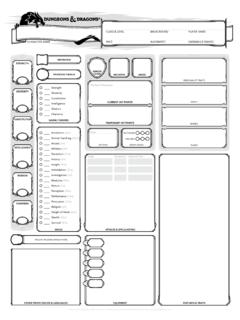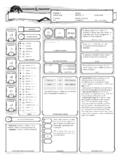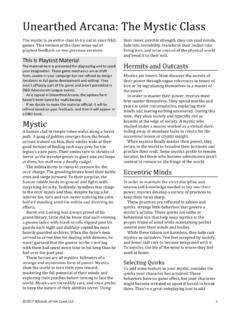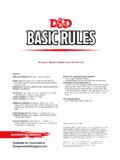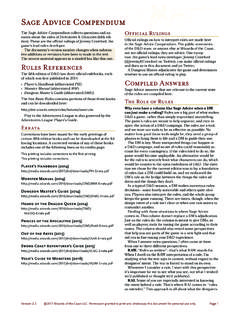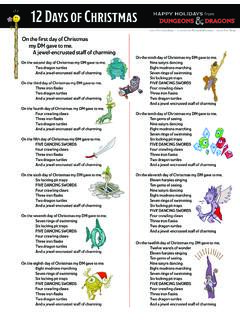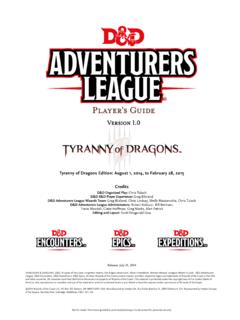Transcription of Unearthed Arcana: Downtime
1 2017 Wizards of the Coast LLC 1 Unearthed Arcana: Downtime This Is Playtest Material The material here is presented for playtesting and to spark your imagination. These game mechanics are in draft form, usable in your campaign but not refined by design iterations or full game development and editing. They aren t officially part of the game and aren t permitted in D&D Adventurers League events. If we decide to make this material official, it will be refined based on your feedback, and then it will appear in a D&D book. In a typical campaign, it s possible for the characters to start at 1st level, dive into an epic story, and reach 10th level and beyond in a short amount of time. While that pace works fine for many campaigns, some DMs prefer a campaign with pauses built into it times when adventurers do things other than go on adventures.
2 By introducing Downtime activities that take weeks, months, or even years of effort, you can give your campaign a longer timeline that allows events in the world to play out over the course of years. Wars begin and end, tyrants come and go, and royal lines rise and fall over the course of an entire lifetime of adventure. The Downtime rules also provide ways for characters to spend the monetary treasure they amass on their adventures. The options given here can be used as alternatives to the Downtime options in the Player s Handbook and Dungeon Master s Guide, or you can use the material here to inspire your creation of new options. Overview The Downtime system presented here is built on two basic elements.
3 First, it offers short-term activities, ones that can usually be completed in a workweek (5 days) or longer. These activities cover what characters at levels 1 10 might do between adventures. It includes buying or creating magic items, pulling off heists, and working a job. Higher level characters can also use these activities, but they have the resources and power to take on greater ambitions beyond the scope of these rules. Second, this Downtime system introduces the concept of foils. Foils are NPCs who oppose the characters or whose goals put them against the party. A foil might be a villain who wishes to destroy the characters, or a good-aligned cleric who sees the characters as meddlers and troublemakers.
4 Foils work their plots while the characters engage in Downtime activities, introducing interesting complications to the campaign. The Basics The Downtime system allows characters to pursue long-term activities between game sessions. A character selects a Downtime activity and pays the cost of that activity in time and money. You, as DM, then follow the rules for the activity to resolve it, informing the player of the results and any complications that ensue. Choosing an Activity As DM, you should present the players with a list of activities they can pursue. These activities work for characters of any level. The activities you allow depend on your campaign and the nature of the area where the characters are.
5 For example, you might disallow the creation of magic items, or decide that the characters are in a town that is too isolated from major markets for them to buy such items. You decide which activities are available, not the players. Consider handling Downtime away from the game table. For example, you could have the players pick their activities at the end of a session, by email or text, or when you next see them in person. Resolving Activities Each activity tells you how to resolve it. Many require a check, so be sure to note the character s bonuses as needed. Follow the steps in the activity and determine the results. Most activities require a workweek (5 days) or more to complete. Some activities require days, weeks (7 days apiece), or months (30 days apiece).
6 A character must spend 8 hours of each day engaged in the Downtime activity for that day to count toward the activity s completion. The days don t need to be consecutive. If you want multiple weeks to pass in the campaign world between sessions, report back 2017 Wizards of the Coast LLC 2 the results of any Downtime activities and ask for each character s next moves. Otherwise, you can send out the results to each player by text or email, or catch the players up at the start of the next session. If an activity requires some decisions, you can have the players decide either before the next session or at the start of it. Some DMs like to focus on the activity, but for some groups it s a good idea to let the players talk things out, so long as it doesn t drag out and eat up too much time at the game table.
7 Complications Each activity includes complications you can throw at the characters. Complications are meant to add flavor, depth, and drama to the campaign. They might spawn entire adventures, introduce NPCs who vex the party, and give the characters headaches as they try to navigate the politics and social network of the community they re in. In general, there is a 10 percent chance that a given activity has a complication. You can use them more or less often, depending on what you feel is best for your campaign. Complications can also come from the party s foils, as described below. In the complication table for an activity, the options that are most likely to involve a foil are marked.
8 Foils Foils are NPCs who actively oppose the characters. They might be villains you have featured in past adventures or plan to use in the future. They can also include good or neutral folk who are at odds with the characters, whether because they are rivals, they have opposing goals, or they simply dislike one another. The cultist of Orcus, whose plans the characters have foiled; the ambitious merchant prince who wants to rule the city with an iron fist; and the nosy high priest of Helm who is convinced the characters are up to no good are all examples of foils. A foil is an NPC with an agenda that changes over time. As the characters take Downtime between adventures, their foils rarely rest, continuing to spin plots and work against the characters.
9 Creating a Foil The first step in creating a foil is building an NPC or picking one from your current cast of characters. It s a good idea to have two or three foils at a time, each with an agenda. At least one should be a villain, and the others might be neutral or good. Their conflict with the characters might be social or political, rather than include direct attacks. The best foils are personal. Find links in the characters backstories or recent adventures that provide a good explanation for what sparked the foil s actions. The best trouble for the characters is trouble they created for themselves. Example Foils d20 Foil 1 Tax collector who is convinced the characters are dodging fees 2 Politician who is concerned that the characters are causing more trouble than they solve 3 High priest who worries the characters are diminishing the temple s prestige 4 Wizard who blames the characters for some recent troubles 5 Rival adventuring party 6 Bard who loves a scandal enough to spark one 7 Childhood rival or member of a rival clan 8 Scorned sibling or parent 9 Merchant who blames the characters for any business woes 10 Newcomer out to make a mark on the world 11 Sibling or ally of defeated enemy 12 Official seeking to restore a tarnished reputation 13 Deadly foe disguised as a social
10 Rival 14 Fiend seeking to tempt the characters to evil 15 Spurned romantic interest 16 Political opportunist seeking a scapegoat 17 Traitorous noble looking to foment a revolution 18 Would-be tyrant who brooks no opposition 19 Exiled noble looking for revenge 20 Corrupt official paranoid that crimes will be revealed Motivation An effective foil has a clear reason for interfering with the characters plans. Think about what the foil wants, how and why the characters stand in the way, and how the conflict could be resolved. 2017 Wizards of the Coast LLC 3 Motivation is the why behind a foil s actions. It s the foundation for the NPC s role in the campaign. The Example Foils table offers some examples you can build from.
